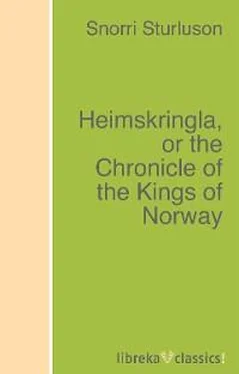Snorri Sturluson - Heimskringla, or the Chronicle of the Kings of Norway
Здесь есть возможность читать онлайн «Snorri Sturluson - Heimskringla, or the Chronicle of the Kings of Norway» — ознакомительный отрывок электронной книги совершенно бесплатно, а после прочтения отрывка купить полную версию. В некоторых случаях можно слушать аудио, скачать через торрент в формате fb2 и присутствует краткое содержание. Жанр: unrecognised, на английском языке. Описание произведения, (предисловие) а так же отзывы посетителей доступны на портале библиотеки ЛибКат.
- Название:Heimskringla, or the Chronicle of the Kings of Norway
- Автор:
- Жанр:
- Год:неизвестен
- ISBN:нет данных
- Рейтинг книги:3 / 5. Голосов: 1
-
Избранное:Добавить в избранное
- Отзывы:
-
Ваша оценка:
- 60
- 1
- 2
- 3
- 4
- 5
Heimskringla, or the Chronicle of the Kings of Norway: краткое содержание, описание и аннотация
Предлагаем к чтению аннотацию, описание, краткое содержание или предисловие (зависит от того, что написал сам автор книги «Heimskringla, or the Chronicle of the Kings of Norway»). Если вы не нашли необходимую информацию о книге — напишите в комментариях, мы постараемся отыскать её.
libreka classics – These are classics of literary history, reissued and made available to a wide audience.
Immerse yourself in well-known and popular titles!
Heimskringla, or the Chronicle of the Kings of Norway — читать онлайн ознакомительный отрывок
Ниже представлен текст книги, разбитый по страницам. Система сохранения места последней прочитанной страницы, позволяет с удобством читать онлайн бесплатно книгу «Heimskringla, or the Chronicle of the Kings of Norway», без необходимости каждый раз заново искать на чём Вы остановились. Поставьте закладку, и сможете в любой момент перейти на страницу, на которой закончили чтение.
Интервал:
Закладка:
4. GUNHILD'S SONS AND GRJOTGARD.
Earl Sigurd had a brother called Grjotgard, who was much younger, and much less respected; in fact, was held in no title of honour. He had many people, however, about him, and in summer went on viking cruises, and gathered to himself property. Now King Harald sent messengers to Throndhjem with offers of friendship, and with presents. The messengers declared that King Harald was willing to be on the same friendly terms with the earl that King Hakon had been; adding, that they wished the earl to come to King Harald, that their friendship might be put on a firm footing. The Earl Sigurd received well the king's messengers and friendly message, but said that on account of his many affairs he could not come to the king. He sent many friendly gifts, and many glad and grateful words to the king, in return for his friendship. With this reply the messengers set off, and went to Grjotgard, for whom they had the same message, and brought him good presents, and offered him King Harald's friendship, and invited him to visit the king. Grjotgard promised to come and at the appointed time he paid a visit to King Harald and Gunhild, and was received in the most friendly manner. They treated him on the most intimate footing, so that Grjotgard had access to their private consultations and secret councils. At last the conversation, by an understanding between the king and queen, was turned upon Earl Sigurd; and they spoke to Grjotgard about the earl having kept him so long in obscurity, and asked him if he would not join the king's brothers in an attack on the earl. If he would join with them, the king promised Grjotgard that he should be his earl, and have the same government that Sigurd had. It came so far that a secret agreement was made between them, that Grjotgard should spy out the most favourable opportunity of attacking by surprise Earl Sigurd, and should give King Harald notice of it. After this agreement Grjotgard returned home with many good presents from the king.
5. SIGURD BURNT IN A HOUSE IN STJORADAL
Earl Sigurd went in harvest into Stjoradal to guest-quarters, and from thence went to Oglo to a feast. The earl usually had many people about him, for he did not trust the king; but now, after friendly messages had passed between the king and him, he had no great following of people with him. Then Grjotgard sent word to the king that he could never expect a better opportunity to fall upon Earl Sigurd; and immediately, that very evening, Harald and Erling sailed into Throndhjem fjord with several ships and many people. They sailed all night by starlight, and Grjotgard came out to meet them. Late in the night they came to Oglo, where Earl Sigurd was at the feast, and set fire to the house; and burnt the house, the earl, and all his men. As soon as it was daylight, they set out through the fjord, and south to More, where they remained a long time.
6. HISTORY OF HAKON, SIGURD'S SON.
Hakon, the son of Earl Sigurd, was up in the interior of the Throndhjem country when he heard this news. Great was the tumult through all the Throndhjem land, and every vessel that could swim was put into the water; and as soon as the people were gathered together they took Earl Sigurd's son Hakon to be their earl and the leader of the troops, and the whole body steered out of Throndhjem fjord. When Gunhild's sons heard of this, they set off southwards to Raumsdal and South More; and both parties kept eye on each other by their spies. Earl Sigurd was killed two years after the fall of King Hakon (A.D. 962). So says Eyvind Skaldaspiller in the "Haleygjatal":—
Earl Hakan, with the help of his friends, maintained himself in the Throndhjem country for three years; and during that time (A.D. 963-965) Gunhild's sons got no revenues from it. Hakon had many a battle with Gunhild's sons, and many a man lost his life on both sides. Of this Einar Skalaglam speaks in his lay, called "Vellekla," which he composed about Earl Hakon:—
And he also says:—
And Einar tells also how Earl Hakon avenged his father's murderer:—
The friends on both sides at last laid themselves between, and brought proposals of peace; for the bondes suffered by this strife and war in the land. At last it was brought to this, by the advice of prudent men, that Earl Hakon should have the same power in the Throndhjem land which his father Earl Sigurd had enjoyed; and the kings, on the other hand, should have the same dominion as King Hakon had: and this agreement was settled with the fullest promises of fidelity to it. Afterwards a great friendship arose between Earl Hakon and Gunhild, although they sometimes attempted to deceive each other. And thus matters stood for three years longer (A.D. 966-968), in which time Earl Hakon sat quietly in his dominions.
7. OF HARALD GRAFELD.
King Hakon had generally his seat in Hordaland and Rogaland, and also his brothers; but very often, also, they went to Hardanger. One summer it happened that a vessel came from Iceland belonging to Icelanders, and loaded with skins and peltry. They sailed to Hardanger, where they heard the greatest number of people assembled; but when the folks came to deal with them, nobody would buy their skins. Then the steersman went to King Harald, whom he had been acquainted with before, and complained of his ill luck. The king promised to visit him, and did so. King Harald was very condescending, and full of fun. He came with a fully manned boat, looked at the skins, and then said to the steersman, "Wilt thou give me a present of one of these gray-skins?" "Willingly," said the steersman, "if it were ever so many." On this the king wrapped himself up in a gray-skin, and went back to his boat; but before they rowed away from the ship, every man in his suite bought such another skin as the king wore for himself. In a few days so many people came to buy skins, that not half of them could be served with what they wanted; and thereafter the king was called Harald Grafeld (Grayskin).
8. EARL EIRIK'S BIRTH.
Earl Hakon came one winter to the Uplands to a feast, and it so happened that he had intercourse with a girl of mean birth. Some time after the girl had to prepare for her confinement, and she bore a child, a boy, who had water poured on him, and was named Eirik. The mother carried the boy to Earl Hakon, and said that he was the father. The earl placed him to be brought up with a man called Thorleif the Wise, who dwelt in Medaldal, and was a rich and powerful man, and a great friend of the earl. Eirik gave hopes very early that he would become an able man, was handsome in countenance, and stout and strong for a child; but the earl did not pay much attention to him. The earl himself was one of the handsomest men in countenance,—not tall, but very strong, and well practised in all kinds of exercises; and withal prudent, of good understanding, and a deadly man at arms.
9. KING TRYGVE OLAFSON'S MURDER.
It happened one harvest (A.D. 962) that Earl Hakon, on a journey in the Uplands, came to Hedemark; and King Trygve Olafson and King Gudrod Bjornson met him there, and Dale-Gudbrand also came to the meeting. They had agreed to meet, and they talked together long by themselves; but so much only was known of their business, that they were to be friends of each other. They parted, and each went home to his own kingdom. Gunhild and her sons came to hear of this meeting, and they suspected it must have been to lay a treasonable plot against the kings; and they often talked of this among themselves. When spring (A.D. 963) began to set in, King Harald and his brother King Gudrod proclaimed that they were to make a viking cruise, as usual, either in the West sea, or the Baltic. The people accordingly assembled, launched the ships into the sea, and made themselves ready to sail. When they were drinking the farewell ale,—and they drank bravely,—much and many things were talked over at the drink-table, and, among other things, were comparisons between different men, and at last between the kings themselves. One said that King Harald excelled his brothers by far, and in every way. On this King Gudrod was very angry, and said that he was in no respect behind Harald, and was ready to prove it. Instantly both parties were so inflamed that they challenged each other to battle, and ran to their arms. But some of the guests who were less drunk, and had more understanding, came between them, and quieted them; and each went to his ship, but nobody expected that they would all sail together. Gudrod sailed east ward along the land, and Harald went out to sea, saying he would go to the westward; but when he came outside of the islands he steered east along the coast, outside of the rocks and isles. Gudrod, again, sailed inside, through the usual channel, to Viken, and eastwards to Folden. He then sent a message to King Trygve to meet him, that they might make a cruise together in summer in the Baltic to plunder. Trygve accepted willingly, and as a friend, the invitation; and as heard King Gudrod had but few people with him, he came to meet him with a single boat. They met at Veggen, to the east of Sotanes; but just as they were come to the meeting place, Gudrod's men ran up and killed King Trygve and twelve men. He lies buried at a place called Trygve's Cairn (A.D. 963).
Читать дальшеИнтервал:
Закладка:
Похожие книги на «Heimskringla, or the Chronicle of the Kings of Norway»
Представляем Вашему вниманию похожие книги на «Heimskringla, or the Chronicle of the Kings of Norway» списком для выбора. Мы отобрали схожую по названию и смыслу литературу в надежде предоставить читателям больше вариантов отыскать новые, интересные, ещё непрочитанные произведения.
Обсуждение, отзывы о книге «Heimskringla, or the Chronicle of the Kings of Norway» и просто собственные мнения читателей. Оставьте ваши комментарии, напишите, что Вы думаете о произведении, его смысле или главных героях. Укажите что конкретно понравилось, а что нет, и почему Вы так считаете.












